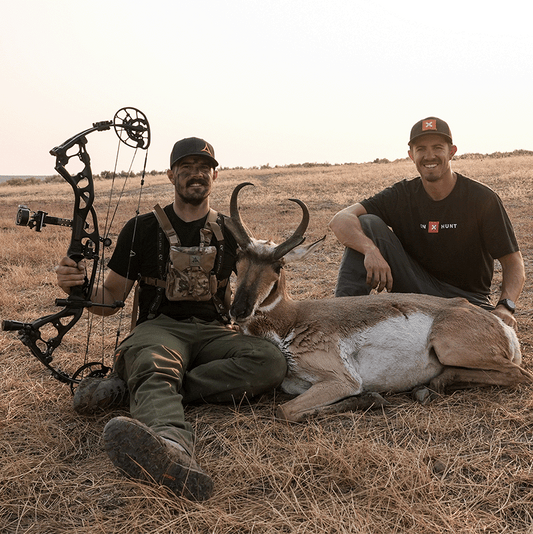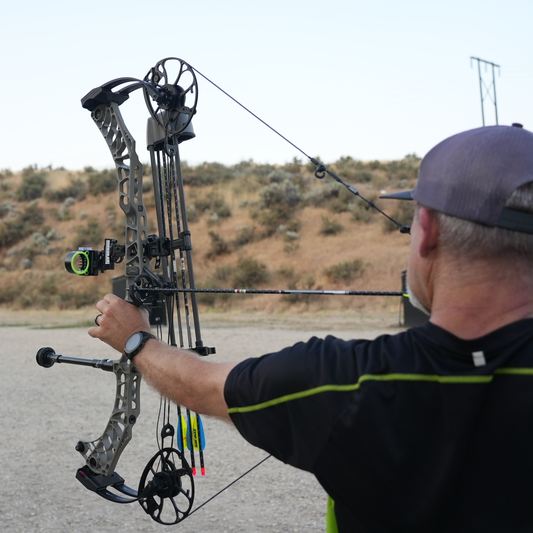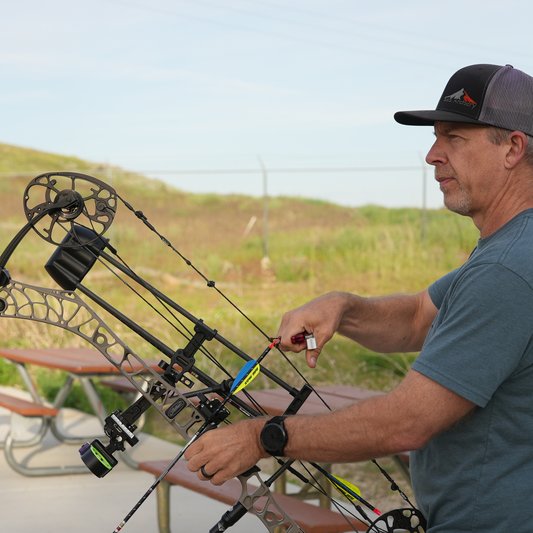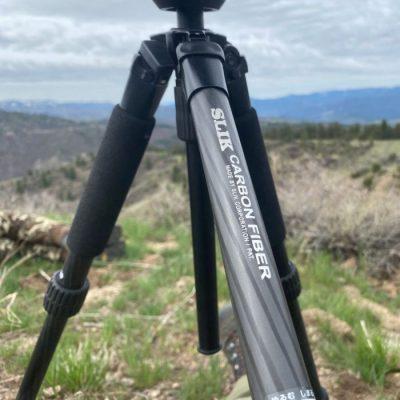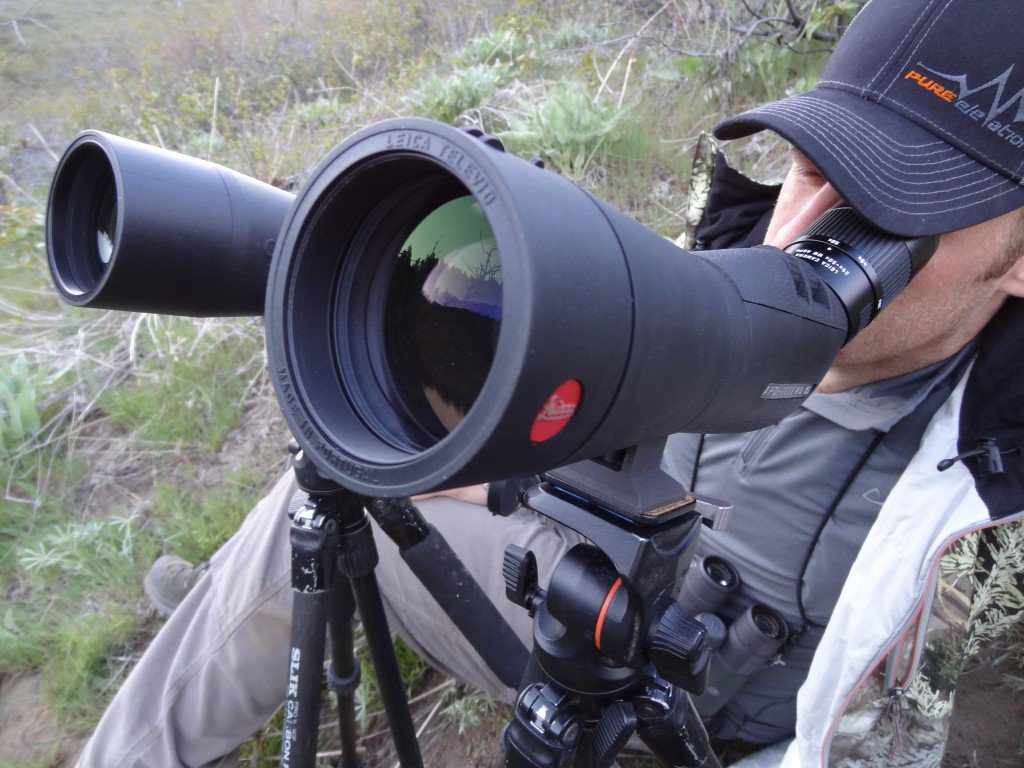Best of the Best 65mm Spotting Scope Review
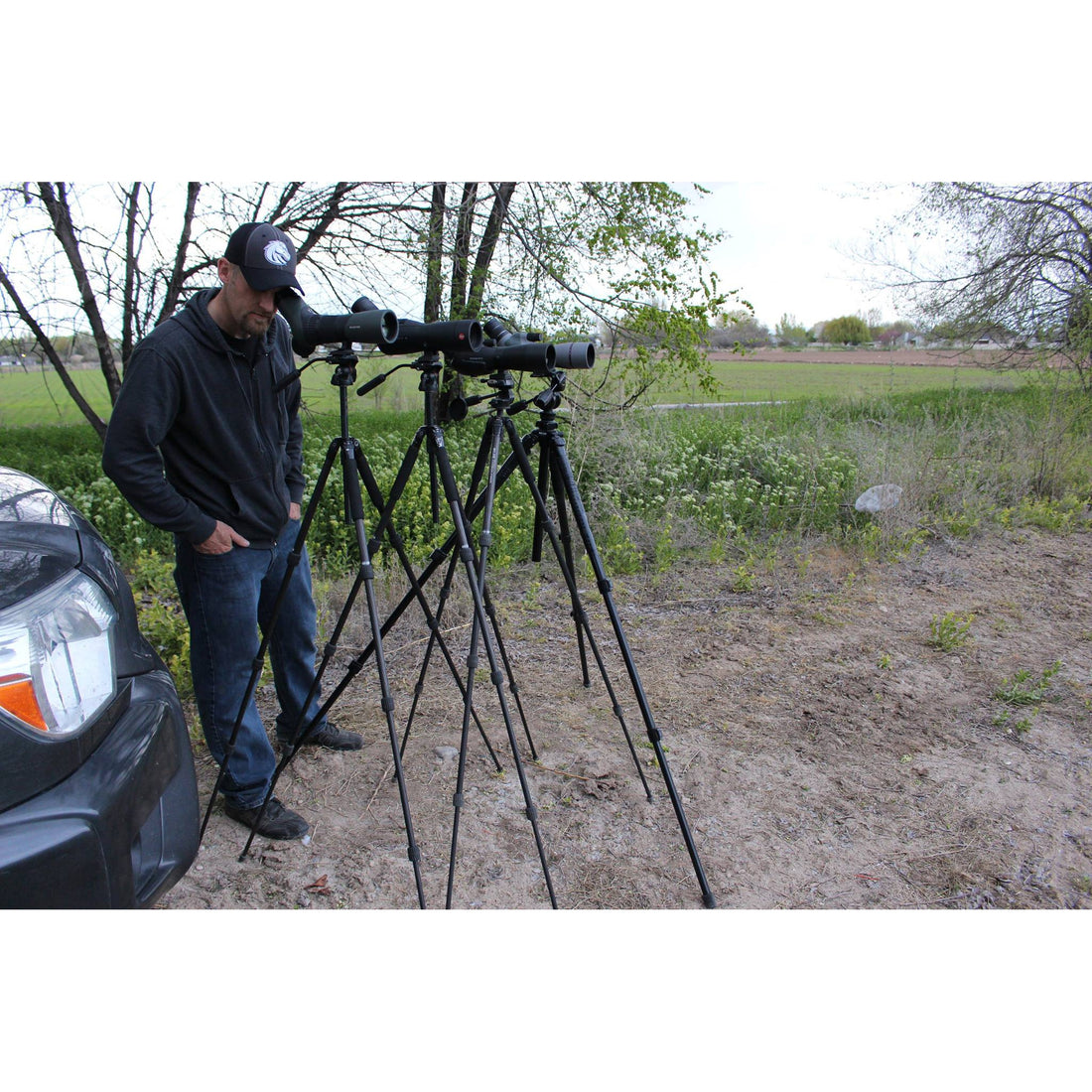
Best of the Best 65mm Spotting Scope Review- by Jason Wright
If you’ve ever hunted mule deer out west, you understand the importance of a quality spotting scope. A quality spotter can save you miles of hiking and literally change the way you hunt. But none of that matters if you leave the scope at the truck because it’s too heavy or too bulky to pack. The 65mm spotting scope category represents the perfect mix of optical performance without excessive weight. For this review we’ve narrowed the 65mm market down to what we think are the best angled* spotters on the market: Swarovski ATX 65, Leica APO-Televid 65, Zeiss Diascope 65, and the Vortex Razor 65. We’ll be comparing these scopes based on
Optical performance Features, Size/weight, and Value.
*Side note: We chose to review angled spotters simply because they are the most versatile all-around spotting scopes for hunting. If you've ever spent hours on end with a kink in your neck trying to align your eye to a straight spotter you know what we are talking about. We spent several weeks reviewing these 4 scopes every chance we had. Trying to simulate every hunting situation, we compared these scopes head to head at first light, last light, and mid-day. We ranked scopes in 4 categories; Lowlight performance, definition, color/contrast, and edge to edge clarity.
|
|
Leica APO-Televid 25-50Wx65mm | Swarovski ATX 25-60x65mm | Zeiss Diascope 15-56x65mm | Vortex Razor 16-48x65 |
| Optical Performance | ||||
| Lowlight Performance | 4.75/5 | 4.75/5 | 4.5/5 | 4.5/5 |
| Definition | 5/5 | 5/5 | 4.75/5 | 4.25/5 |
| Color/Contrast | 5/5 | 4.5/5 | 4.25/5 | 4.25/5 |
| Edge to Edge Clarity | 5/5 | 5/5 | 4/5 | 4.25/5 |
| Overall | 19.75/20 | 19.25/20 | 17.5/20 | 17.25/20 |
| Specifications | ||||
| FOV (1000 yards) | 123ft/84ft | 124ft/68ft | 156ft/63ft | 138ft/75ft |
| Magnification | 25-50x | 25-60x | 15-56x | 16-48x |
| Exit Pupil | 2.6-1.3mm | 2.6-1.1mm | 4.3- 1.2mm | 4.1-1.4mm |
| Max Eye Relief | 19mm | 20mm | 16mm | 20mm |
| Weight (Factory) | 55.9oz | 54.9oz | 56.8oz | 48oz |
| Actual (w/caps) | 58oz | 58.7oz | 56.8oz | 50.6oz |
| Features | ||||
| Focus Adjustment | 4.5/5 Dual Speed | 4.5/5 One speed | 4/5 Hybrid Dual speed | 4.75/5 Dual Speed |
| Sunshade | Yes | Yes | Yes | Yes |
| Eye cup | Twist-click | Twist-up | Twist-click | Twist-up |
| Price | $2999.99 | $3278.00 | $2399.95 | $1199.00 |
Optical Performance
Lowlight Performance
To score well in this category a scope must maintain a bright image up to the last few moments of daylight as well as do a good job glassing into shadows. Both the Leica and the Swaro did a great job with light transmission but they seemed to excel in different areas. The Leica had a noticeable advantage over the Swaro when it came to glassing into dark shadows in the last few hours of daylight. But as light continued to fade the Swaro made a come back and became noticeably brighter, in the last ten minutes of glassing light. The Zeiss and the Vortex both did well in lowlight, but just weren’t on the same level as the Leica and Swaro. The Zeiss was a touch brighter than the Vortex but overall I was really impressed with the Vortex’s ability to hang with the much more expensive competition.
Definition (Resolution)
Resolution is basically the scopes ability to see fine detail in distant objects. So obviously the scopes with higher magnification will ultimately offer better resolution; in this case the Swaro at 60x and the Zeiss at 56x. So to level the playing field we did resolution testing at 50x. We started with trying to read text on distant signs but eventually ended up using a resolution chart for the most consistent results. We used the Tinesup Point and shoot system to take a few pictures of this resolution chart testing. With this set-up we were able to take some great pictures with each scope. But unfortunately the results weren’t conclusive. Occasionally the stars would align and we would get a flawless picture out of a scope that in our opinion wasn’t the sharpest most defined scope. But here are the best images from each scope and we’ll let you decide which one you think looks the best. In the end my personal favorite was the Swarovski based solely on the fact I had an easier finding that perfectly focused sweet spot, especially when using the digiscoper. The Leica and Zeiss were just as impressive in overall resolution but just not as user friendly for me. The Vortex didn't really compare in overall resolution but did well when you consider it's price point.Color/Contrast
To score well in this category a scope needs to produce a high contrast image, with bright vibrate colors and minimal to no color bias. The clear winner in this category was without a doubt the Leica. The Leica’s high contrast image produced colors that just seemed to jump out at you more than any other scope. By comparison the colors produced by the Swarovski and the Vortex seemed flat and a little dull. While they both still offered sufficient contrast needed to spot game, they just didn’t compare to the Leica. The Zeiss did a great job with contrast, but had a slight greenish/blue hue to the image. If the colors would have been more neutral we would have given the Zeiss a higher score.Edge to Edge Clarity.
Overall the best edge to edge clarity went to the Leica. Despite Swarovski’s “Field flattener lens” that claims to offer the best edge to edge clarity to date; the Leica just looked better on the edges of the glass. The Zeiss was super clear in the middle of the scope but seemed to have a little distortion as you moved towards the edges of the scope. In my opinion it didn’t seem to have the flat field of view that the other scopes had. To my eye the Vortex had a flatter field of view than the Zeiss but was a touch behind on the clarity and sharpness.
Features
When you’re trying to make a decision on which scope to go with optical performance is going to be everyone’s first priority. Since these scopes are so extremely comparable optically it might come down to what features appeal to you the most. The key features in our opinion are; zoom range, eye relief, field of view (FOV), Focus wheel, magnification control, Eye cups and Lens caps.Zoom Range
Zoom range is usually fairly consistent, over the years we have been accustomed to 15-45 and 20-60 magnifications. More recently other options have been popping up most noticeably the 15-56 of the Zeiss and the 25-60 wide angle eyepiece of the Swaro. In this review we don’t have a single standard zoom range, the closest being the 16-48 of the Vortex. Having a larger zoom range is typically really good to have but it usually comes at the expense of optical quality. One reason why we feel the Zeiss 15-56 wasn’t near as sharp as the others on the edge. It seems they focused on having a super sharp image in the center of the view at the expense of poor edge to edge quality. With that much zoom range you really can’t have both. This is also a reason why we think the Leica was the best in resolution as it has the smallest zoom range of 25-50. In this review we both felt that the Swaro was the clear winner here, with the wide angle view at 25x (the same as the Leica) but the max end of 60x this gave us the wide field of view that we both like and also the max of 60x for really zooming in to see those little details.Eye Relief
Eye relief is one of those things you never notice until it becomes a problem. Since I don’t wear glasses it’s never really been a problem for me. So I threw on sun glasses to see if I noticed any FOV restrictions on any of the scopes. All scopes offered a full FOV at all zoom ranges. The most generous was the Swarovski at 20mm throughout the zoom range. The Vortex also did well with 20mm eye relief; but only at lower magnifications. From 40-48x the eye relief noticeably dropped and I noticed myself pressing my eye closer to the scope to maintain that full FOV. My FOV was never restricted by the eye relief but it came close. The Leica was also generous throughout the entire zoom range with 19mm of eye relief. The Zeiss had great eye relief at the lower 15x and the max 56x but declined a lot in the middle ranges of 25-40x. It still offered a full FOV but cut it pretty close on the middle ranges.
Field of View
In my opinion when it comes to FOV the wider the better. If you’ve never looked through a wide angle eyepiece the best way to describe it would be comparing it to an “I-Max” theater, whereas a narrower FOV scope can feel like sitting in the back row of a normal theater. The Leica and the Swaro both have that “I-Max” feel to them where the image just seems to jump out at you. In contrast the Vortex’s image seems to be at the end of a dark tube. The Zeiss falls somewhere in between because of its wide FOV but blurry edges.
Focus Wheel
The focus wheel can play a major part in the ability to easily operate the spotting scope. When at full magnification having the ability to fine focus and also not shake the scope is a huge benefit. For both Steve and I the Swaro and Vortex were both just about tied for the best. Steve slightly preferred the dual focus knob of the Vortex and I like the large center focus of the Swaro. The Zeiss had a unique dual focus that was built into one knob and we found it a little awkward to operate. I am sure its something you would get used to over time but it definitely has a learning curve. The Leica is very similar to the Vortex with two focus knobs but they are slightly recessed into the scope and sometimes its hard to tell which one you are on. The fine focus knob also seemed just a little too fast, there wasn’t as big as difference between it and the coarse knob like the Vortex had.Conclusion/Summary:
Its amazing how many hunters and optics enthusiasts have preconceived opinions about what brand of optics are the best. Whether based on great marketing or actual in field experience; brand loyalty can really skew ones opinion on which scope is the best, especially when the competition is this close. I personally have used Swarovski for the past 4 years and will admit that it might have influenced my initial favorite during the first few weeks of this review. But after 4 weeks of thorough head to head comparisons I’m confident the conclusion I’ve drawn is accurate and unbiased. If you’re looking for the best overall image with; great contrast, vibrant colors and a crystal clear wide FOV the go with the Leica. If you are looking for more resolution at longer distances you won’t be disappointed with either the Swaro or Zeiss for their long range capability. And last but not least if you are looking for the best value, you owe it to yourself to check out the Vortex. Jason WrightSteve’s overview
Starting out I thought this test was going to be easy, there would be a clear winner right out from the gate and the rest would just be organizing where the others fell into place. This proved to be far from the case. There are so many variables to consider even just outside of optical performance from weight, size, cost, focus wheel, features and the varying zooms with their prospective field of view. These were all so close in fact that from day to day as the glassing conditions changed our opinions changed. One day the Swaro seemed to be the winner, the next day the Vortex was hanging right in there and the next day the Leica was the clear winner, etc. The overall summary is all of the spotters in this test are at the pinnacle of optical performance and I really don’t think you could buy one and regret the purchase. Breaking down this review we are really getting to the fine details about each scope to weed out a winner. 
For me after spending hours and hours behind each scope if I was to base the winner purely off optical performance Leica takes the cake. The clarity, resolution, brightness and contrast (colors and objects really seem to pop in the image over all the others) won me over. I also really like the 25-50 wide angle eyepiece, having that larger field of view really makes a difference for me as I like to do a lot of glassing and gridding hillsides through my spotter. Using the Leica in the field next to the Swaro I really didn’t find myself missing the extra 10x the Swaro provides but I could see that would be nice in certain situations (if you’re trying to figure out if that buck’s kicker is 3 or 4”). My two complaints about the Leica are I don’t really like the focus wheel design (its not bad but I prefer the Vortex and Swaro) and its tied right up there with the Swaro for the heaviest. Throwing another major wrinkle into the review is the Vortex Razor HD at the price point of $1199. This scope continually impressed me as we did resolution tests, in the field glassing and so on. There were a handful of times I actually preferred the Vortex image over some of the others. For the guy looking to get the best glass he possibly can at the best price it’s a no decision that you buy the Vortex. The build quality is excellent, the size and weight were the best in the test, the focus wheel is smooth and precise and optically its hangs with Leica and Swaro more often than not. I think for the average western hunter who gets out 5 or 6 weekends a year hunting deer and elk it’s a no brainer to buy the Vortex. If you’re headed to AK on a Dall sheep hunt and need to count horn age rings or have a once in a lifetime tag somewhere it’s worth looking at the other options.
The Swaro I have to say I was disappointed in when we were doing head to head tests against the Leica. More often than not I preferred the Leica image, sometimes they were close and sometimes it wasn’t even close. For example we did some glassing across a canyon into a dark timber patch, the Leica was bright and clear with great contrast. I could see the bark on the trees and dead sticks on the ground as clear as if they were 5 feet in front of me. The Swaro had a dull and hazy appearance to it so much so that we started looking at the glass to make sure it wasn’t covered in dust or something. However on another day doing resolution tests the Leica and Swaro were neck and neck. I can’t really put my finger exactly on what was going on but for some reason the Leica was just consistently performing better where the Swaro would look amazing at times and be disappointing at others. My best guess is the contrast and colors are definitely better in the Leica and under certain lighting conditions you could really see it and others the two seemed the same.
I think everyone (myself included) has a pre-conceived notion that Swaro because of their reputation is just automatically going to be the best. Kudos to them and their marketing team! I can say with 100% confidence that even the most diehard Swaro fans could not spend an hour glassing side by side with the two spotters and not admit the Leica was better. I did however really like the focus wheel and zoom ring on the Swaro, it’s a really well thought out system. Also the modular ability to go to the larger 85 and 95mm objectives could be a pretty enticing feature for some guys.
The Zeiss was definitely the odd ball in the test. We did have the 15-56 eyepiece and that zoom range is incredible. I think that was also a major factor on why the Zeiss didn’t perform as well in the test, trying to cram that much zoom into an eyepiece you are going to lose optical quality. Zeiss did do an amazing job keeping the very center of the image nice and sharp but at 15x there is a fuzzy ring that covers the outer ¼ of the image. As you zoom in that starts to get better but the field of view is so small it has a very tunnel image effect. Resolution at 56x surprisingly was as good as the Leica and Swaro, it was really quite impressive. The other thing both Jason and I noticed was the Zeiss has a very green hue to it that made the image darker than the others. I am not sure why they do this but it was very noticeable in the head to head test. Overall I don’t think I would recommend the Zeiss with the 15-56 eyepiece except for that good old variable of cost! At $2400 it’s a lot cheaper than the Leica and Swaro and at times can provide an outstanding image. I definitely want to get my hands on their 15-45 eyepiece and see how that does here soon.
The short and sweet conclusion: Leica is the best optics, Swaro was disappointing compared to Leica but its modular features and zoom range are very attractive, Zeiss I wouldn't buy and Vortex is hands down the winner for those looking to save some money and for those who can live with knowing they don’t have the “best” but something that is very close.
-Steve Speck

